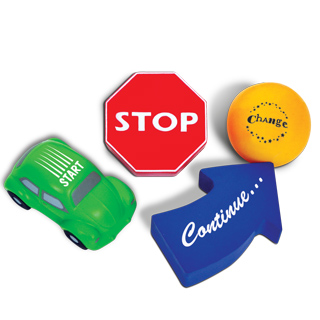
On the journey from “where you are today” to “where you want to be,” it is just as important to identify what you want to KEEP as what you want to CHANGE. One of my favorite tools to engage people in that conversation is Stop-Start-More (SSM), which works like this:
In service of <this goal/vision/aspiration>:
What do I need to STOP doing?
What do I need to START doing?
What do I need to do MORE of?
In other words, let’s identify:
- What gets in your way?
- What you need to create, and
- What tools and conversations and processes and skills do you already possess that you can leverage anew to move you to the goal?
I love the exercise because it gives attention to strengths. The approach acknowledges what is already working and may simply need to be turned up a notch or repurposed.
SSM is a wonderful coaching tool I use to pull people out of what I call the “running away from…” goal framework. You know what I mean: I want to AVOID anger. I want to STOP procrastinating. I want to QUIT being impatient. OK, great; yet those statements identify only what you are running away from. What do you want? What’s the powerful positive to pull you forward? What have you got to work with already?
Here’s a quick example:
I want to live a healthy(ier) life. To support that goal:
- What do I need to STOP doing? Maybe the daily fast food lunches. Stocking the house with junk food. Saying No when friends invite me to the gym. Unsustainable drastic/fad diets. Focusing on denial.
- What do I need to START doing? Walk at lunch. Shop differently. Keep a food log. Go to yoga class.
- What do I need to Do MORE of? Sleep – to bed an hour earlier. Take the stairs. Cook larger meals and freeze for rushed days. Add more variety so I don’t get bored and stop.
Notice that SSM is not just about one response to each question; it’s about generating ideas for yourself then looking for the strongest themes and using those.
What do you need to STOP doing to be Happier?
- Worrying about what other people think about you. You don’t need other people’s approval to be happy.
- Comparing yourself to others. Live your own life vs. compete with others.
- Beating yourself up over yesterday’s mistakes. If life is a book, yesterday was just one chapter. Focus on the next one.
- Hanging on to resentment. Forgiveness is the strongest thing you can do for yourself
What do you need to START doing to increase your Happiness?
- Pay attention to the good stuff. Practicing Gratitude and Awe every day strengthens your awareness of positivity in life.
- Fake it to feel it. Act on your happiness; walk with shoulders back and a smile on your face.
- Change your thoughts. It’s often your own stories that hurt you. Write new scripts for yourself.
- Take risks, and fail with grace. Paralysis is an enemy of happiness. Good or bad, make decisions and keep moving and learning.
What do you need to do MORE of to increase Happiness?
- Hang out in happy spaces. Spend more time with the positive people in your life. Wear the clothes that make you feel great. Visit the places where you feel most alive, e.g. nature.
- Breathe on purpose. You’re always taking in air, but it’s way more powerful when you notice and deepen your breath. Ahhhh!
- Reach out and touch others. Connection is one of the pillars of happiness. We become more human when we build relationships.
- Be present. When you focus always on the future, you miss what’s happening right now. Enjoy life as it unfolds.
Summary: there are multiple paths to Happier. Some require giving up what’s not serving you, some require new habits, and some give more time/energy/attention to something you’re already doing. Which path you choose is less important than THAT you choose. Enjoy your journey.
